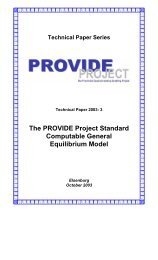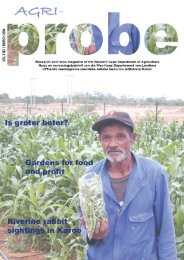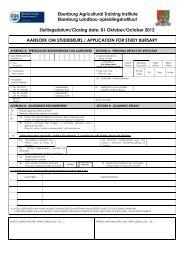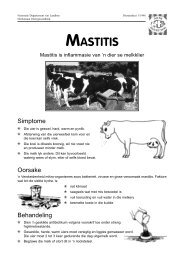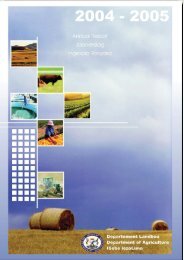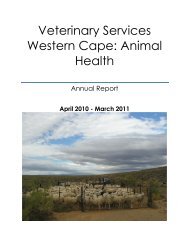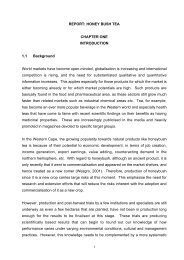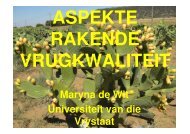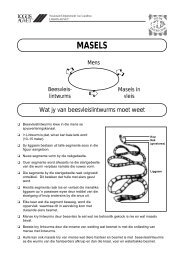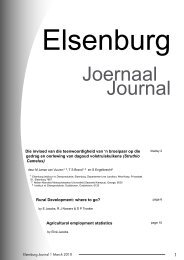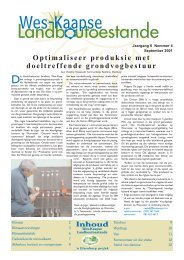Download Elsenburg Joernaal/Journal - Department of Agriculture ...
Download Elsenburg Joernaal/Journal - Department of Agriculture ...
Download Elsenburg Joernaal/Journal - Department of Agriculture ...
Create successful ePaper yourself
Turn your PDF publications into a flip-book with our unique Google optimized e-Paper software.
silage plus concentrate (SC) diet. It was found that the dietary<br />
treatment during the winter had no significant carry-over effect<br />
on performance during the grass-feeding period and there<br />
was no indication <strong>of</strong> compensatory growth by the steers that<br />
received silage alone. Short et al. (1996) conducted a four-year<br />
experiment to determine the effects <strong>of</strong> protein supplementation,<br />
age at weaning and calf sire breed on cow and calf performance<br />
during fall grazing. Some carry-over effects <strong>of</strong> treatments<br />
were observed the next spring in cow weight, condition<br />
score, and birthweight (P < 0.01), but there were no effects by<br />
the next fall on weaning weight or pregnancy rates.<br />
The lack <strong>of</strong> response in the live weight <strong>of</strong> ewes in the present<br />
study could be accounted for by the fact that mature ewes<br />
were used. In a study by Allden (1979), an unrestricted level <strong>of</strong><br />
feeding for the first eight weeks <strong>of</strong> life prior to a lengthy period<br />
<strong>of</strong> restriction was very effective in establishing a high reproductive<br />
potential, compared to restricted nutrition from birth. This<br />
emphasises the importance <strong>of</strong> nutrition early in life. This was<br />
also indicated by Reardon & Lambourne (1966), who indicated<br />
that there may be a critical development period which is very<br />
sensitive to nutrition and which will greatly affect the genetic<br />
potential achieved by the ewes later in their life.<br />
Conclusion<br />
In conclusion, it is evident that supplying supplementary feed in<br />
the previous year did not have a significant carry-over effect on<br />
production in the following year. Although there was a tendency<br />
for ewes to produce more lambs when receiving supplementation<br />
the previous year, the number <strong>of</strong> lambs weaned did not<br />
improve significantly, rendering it economically unjustifiable to<br />
provide supplementation in order to obtain a significant carryover<br />
effect. A probable carry-over effect on the production <strong>of</strong> the<br />
ewes will also be smaller if adequate pasture is supplied in the<br />
dry period. The animals used in the study were mature, while<br />
young growing animals may probably be more exposed to a<br />
possible carry-over effect.<br />
Table 3 :The effect <strong>of</strong> supplementation in both the previous (1998) and<br />
present (1999) year on production <strong>of</strong> SA Mutton Merino ewes in the<br />
following year (mean ± SE)<br />
Production (1999) Treatment in 1998 SEM P<br />
<strong>Elsenburg</strong> <strong>Joernaal</strong><br />
2008 (2)<br />
No supplementation<br />
Supplementation<br />
Ewes:<br />
Initial bodyweight,kg 68.86 70.54 1.01 0.23<br />
Weaning lamb weight/<br />
ewe +++<br />
Lambs:<br />
28.79 30.00 1.37 0.81<br />
Birthweight,kg 4.94a 4.42b 0.12 0.003<br />
Weaning weight,kg 27.95a 25.00b 0.75 0.005<br />
Birth status + 1.09 1.37 0.10 0.07<br />
Weaning status ++ 0.94 1.05 0.10 0.43<br />
Production (1999) Treatment in 1999 SEM P<br />
No supplementation<br />
Supplementation<br />
Ewes:<br />
Initial bodyweight,kg 71.03 68.36 0.98 0.05<br />
Weaning lamb weight/<br />
ewe +++<br />
Lambs:<br />
26.71 32.42 1.37 0.63<br />
Birthweight,kg 4.56 4.80 0.12 0.16<br />
Weaning weight,kg 25.93 27.02 0.76 0.29<br />
Birth status + 1.22 1.24 0.10 0.89<br />
Weaning status ++ + Lambs born/ewes mated<br />
0.96 1.02 0.09 0.64<br />
++ Lambs weaned/ewes mated<br />
+++ Weaning weight <strong>of</strong> lambs x weaning status<br />
Values in rows not followed by the same superscript differ (P < 0.05).<br />
Acknowledgements<br />
The <strong>Elsenburg</strong> Agricultural Research Centre for providing funds<br />
for the experiment. The Technology and Human Resources<br />
for Industry Program (THRIP) for financial contributions to the<br />
project.<br />
References<br />
1. Aitchison, E., 1988. Cereal straw and stubble as sheep feed.<br />
West. Aust. J. Agr. 29, 96-101.<br />
2. Allden, W.G., 1979. Undernutrition <strong>of</strong> the Merino sheep and<br />
its sequelae. V. The influence <strong>of</strong> severe growth restriction<br />
during early post-natal life on reproduction and growth in<br />
later life. Aust. J. Agric. Res. 30, 939-948.<br />
3. Baker, R.D. & Gibb, M.J., 1995. The performance and changes<br />
in body composition <strong>of</strong> steers <strong>of</strong>fered cut grass or grazing<br />
following three patters <strong>of</strong> nutrition in winter. Anim. Sci. 60,<br />
419 – 427.<br />
4. Brand, T.S., Brand, A.A., Cloete, S.W.P. & Durand, A., 1992a.<br />
Untreated, urea-enriched and thermal ammoniated oat grain<br />
as supplementary feed for pregnant and lactating South African<br />
Mutton Merino ewes grazing wheat stubble. S. Afr. J.<br />
Anim. Sci. 22, 58 – 63.<br />
5. Coombe, J.B., 1981. Utilization <strong>of</strong> Low-Quality Residues. In:<br />
Grazing Animals. (Ed. F.W.H. Morley), Elsevier, Amsterdam,<br />
pp. 319-334.<br />
6. Dann, P.R. & Coombe, J.B., 1987. Utilization <strong>of</strong> fodder crops<br />
and crop residues. In: Temperate Pastures, their Production,<br />
Use and Management. (Eds. L.W. Wheeler, C.G. Pearson<br />
and G.E. Robards), Australian Wool Corporation, Australia,<br />
pp. 517-525.<br />
7. Gibb, M.J. & Baker, R.D., 1988. Performance <strong>of</strong> young steers<br />
<strong>of</strong>fered stack-treated ammoniated hay or untreated hay with<br />
or without a supplement. Anim. Prod. 47, 223 – 229.<br />
8. Gunn, R.R., 1983. The influence <strong>of</strong> nutrition on the reproductive<br />
performance <strong>of</strong> ewes. In: Sheep production. (Ed. W.<br />
Haresign), Butterworths, London, pp. 99-110.<br />
9. Hughes, J.H., Stephens, D.F., Lusby, K.S., Pope, L.S., Whiteman,<br />
J.V., Smithson, L.J. & Totusek, R., 1978. Long-term effect<br />
<strong>of</strong> winter supplement on the productivity <strong>of</strong> range cows.<br />
J. Anim. Sci. 47, 816 – 827.<br />
10. Mulholland, J.B., Coombe, J.B., Freer, M. & McManus, W.R.,<br />
1976. An evaluation <strong>of</strong> cereal stubbles for sheep production.<br />
Aust. J. Agric. Res. 27, 881 – 893.<br />
11. Reardon, T.F. & Lambourne, L.J., 1966. Early nutrition and<br />
lifetime reproductive performance <strong>of</strong> ewes. Proc. Aust. Soc.<br />
Anim. Prod. 6, 106-108.<br />
12. Short, R.E., Grings, E.E., MacNeil, M.D., Heitschmidt, R.K.,<br />
Haferkamp, M.R. & Adams, D.C., 1996. Effects <strong>of</strong> time <strong>of</strong><br />
weaning, supplement and sire breed <strong>of</strong> calf during the fall<br />
grazing period on cow and calf performance. J. Anim. Sci. 74,<br />
1701 – 1710.<br />
13. Snedecor, G.W. & Cochran, W.G., 1980. Statistical Methods.<br />
(7th ed.). Iowa State University Press, Ames, Iowa, pp. 593.<br />
14. Weston, R.H. & Hogan, J.P., 1986. Nutrition <strong>of</strong> herbage fed<br />
ruminants. In: The Pastural Industries <strong>of</strong> Australia. (Eds F. Alexander<br />
and O.B. Williams.), Sydney University Press, Sydney,<br />
pp. 233-268.<br />
12



